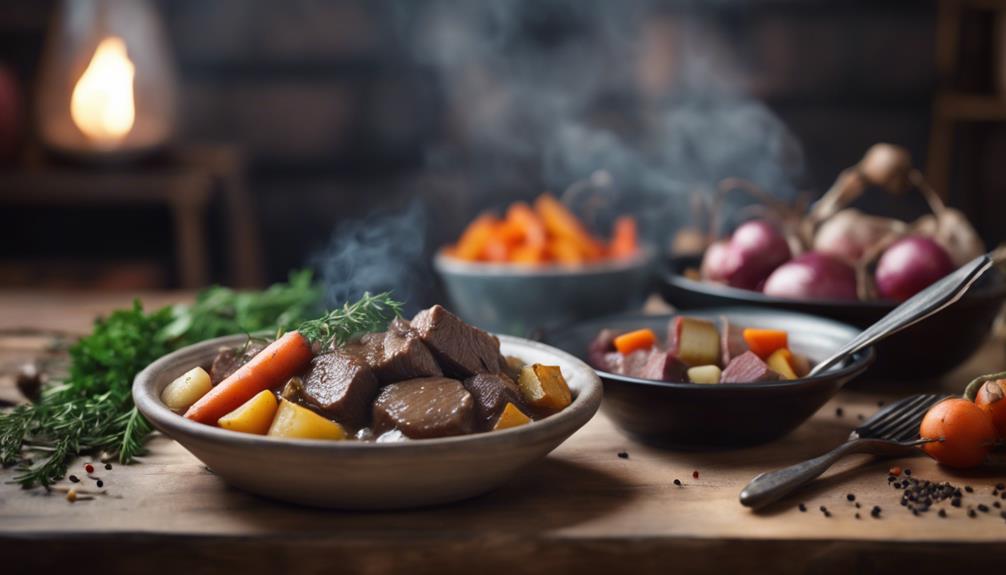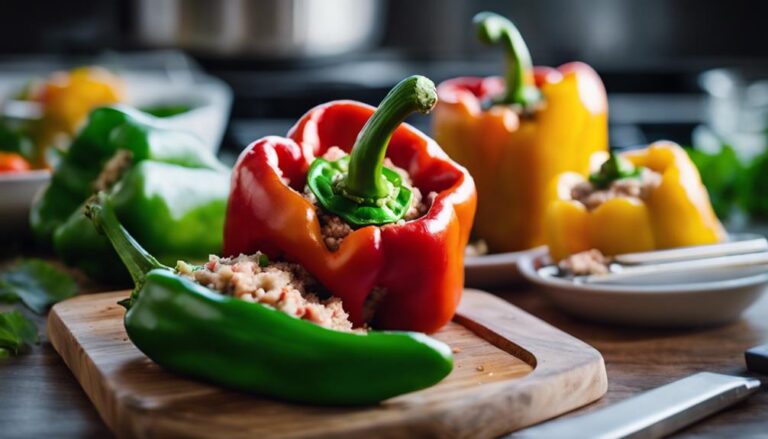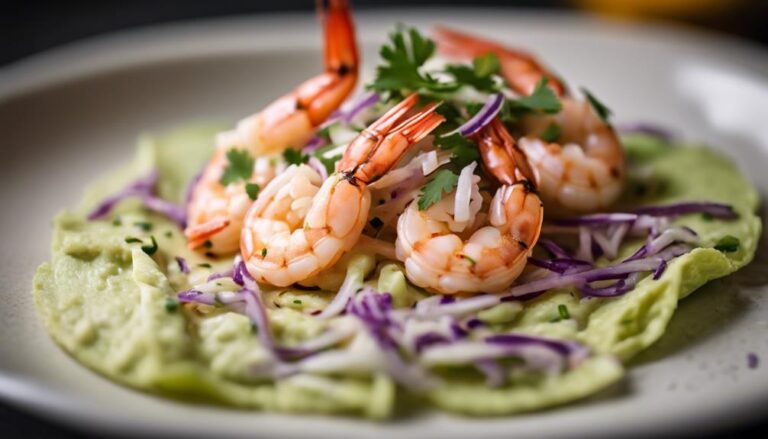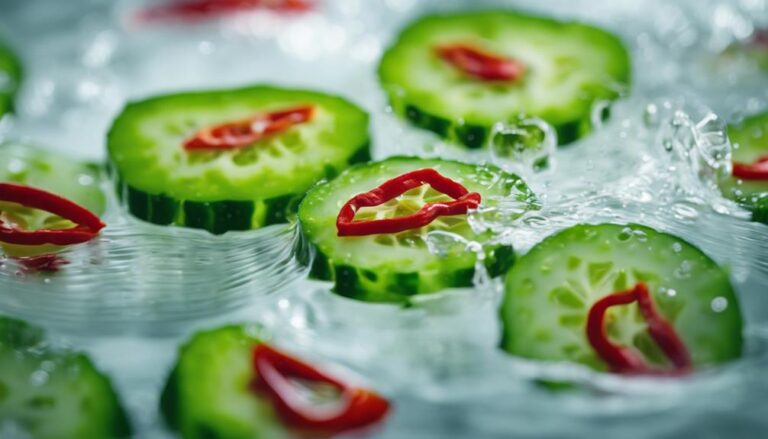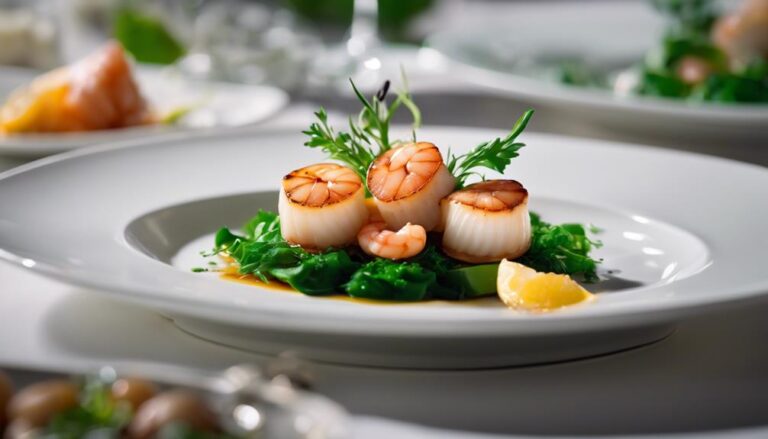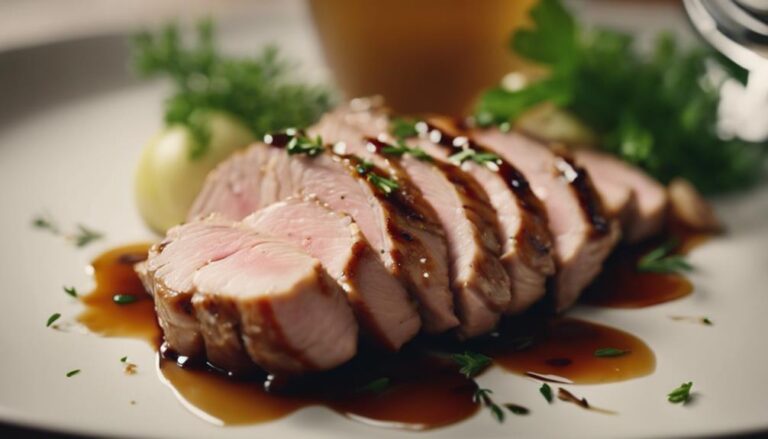Sous Vide Beef Stew With Root Vegetables
Immerse your beef and root vegetables in sous vide perfection. Seal them in bags for precise cooking. Use a digital circulator to control the temperature. Let the tough meat tenderize slowly. Maintain juicy flavors with this innovative method. Enhance your stew's richness with beef broth. Opt for homemade for depth. Explore classic like Wine Beef Stew. Delight in varied flavorful stews. Browning your beef boosts taste and appeal. Achieve a melt-in-your-mouth texture at 185°F for 45 minutes. Discover the splendid results waiting for you.
What You Will Learn Here
- Sous vide cooking ensures perfect tenderness in beef stew.
- Root vegetables maintain firm texture with precise temperature control.
- Browning beef adds robust flavor and visual appeal.
- Thickening sauce with xanthan gum enhances stew's taste.
- Consistent, flavorful results achieved with innovative cooking method.
Sous Vide Cooking Method
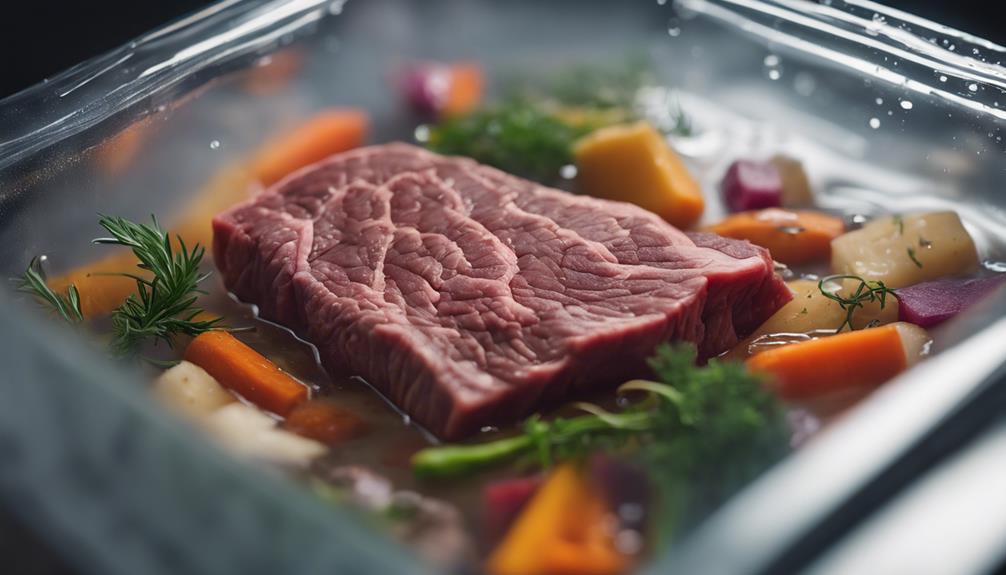
When utilizing the sous vide cooking method, you tightly seal your ingredients in bags, ensuring precise temperature control throughout the cooking process. This technique guarantees uniform cooking, resulting in exceptionally tender and succulent meat every time.
Sous Vide Basics
Utilizing the sous vide cooking method involves vacuum-sealing beef, root vegetables, and other stew ingredients in a bag, then precisely cooking them in a water bath at a controlled temperature. This technique is ideal for tough cuts of meat, like those commonly used in stews, as it guarantees they become tender while retaining their juices and flavors.
Sous vide cooking guarantees consistent results by allowing you to maintain a precise temperature throughout the cooking process. The method's popularity is on the rise among home cooks due to its simplicity and the way it enhances the quality of dishes.
When preparing a sous vide beef stew with root vegetables, remember that this cooking approach is all about precision and excellence in every bite.
Temperature Control
For precise control over cooking temperatures in sous vide, consider utilizing a digital immersion circulator.
Sous vide cooking allows you to set a precise temperature, ensuring consistent results and perfectly tenderizing tough cuts of meat such as chuck roast.
By cooking at a specific temperature like 140°F for an extended period, typically 48 hours, the collagen in tough meat breaks down, resulting in a tender texture.
The water bath method in sous vide cooking plays an essential role in evenly distributing heat around the food, promoting gentle and uniform cooking.
This method minimizes the risk of overcooking, as the food can't surpass the set temperature, leading to juicy and flavorful results.
Mastering temperature control is key to achieving exceptional sous vide dishes.
Cooking Time Management
To optimize your sous vide cooking experience, precise timing management plays an essential role in achieving consistent and perfectly tender results. The table below highlights key points for managing cooking time effectively with sous vide for beef stew:
| Key Aspect | Details |
|---|---|
| Precise Temperature Control | Sous vide allows setting desired temperature & duration for precise results. |
| Constant Temperature | Maintains consistent heat, preventing overcooking and ensuring even cooking. |
| Slow and Even Tenderization | Beef stew meat tenderizes slowly and evenly, resulting in a melt-in-your-mouth texture. |
Beef Broth for Richness
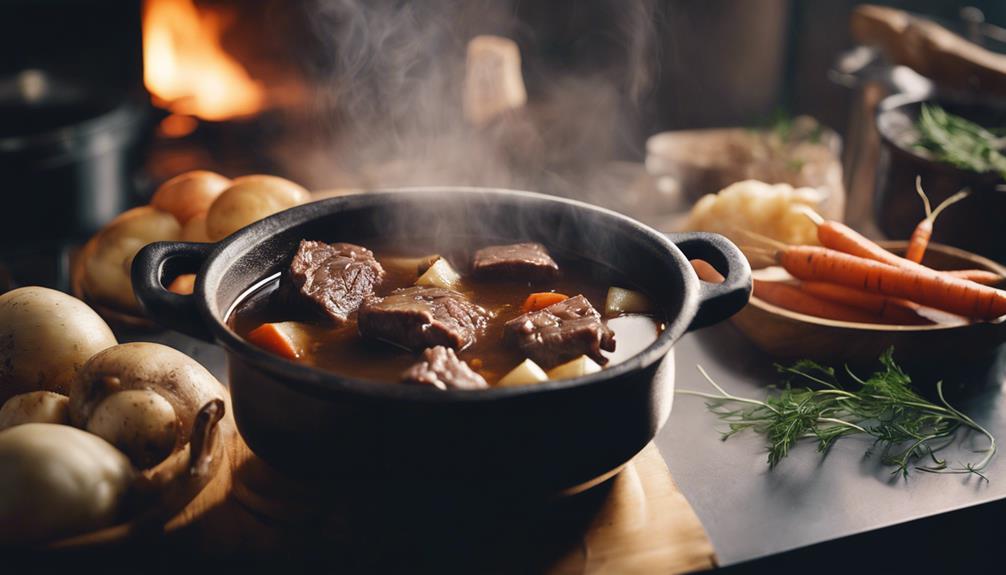
For enhanced depth and a luxurious flavor profile in your sous vide beef stew, consider incorporating a robust homemade beef broth. Here's why beef broth is essential for your stew:
- Umami Boost: Beef broth lends a savory umami note that enhances the overall flavor of the stew, creating a more complex and satisfying taste experience.
- Richness: The homemade beef broth adds a layer of richness and depth to your stew, making it more decadent and flavorful compared to using commercial broths.
- Elevated Taste: Using homemade beef broth elevates the taste of your stew, providing a homemade touch that can't be replicated by store-bought alternatives.
- Well-Rounded Stew: The beef broth acts as the foundation of your stew, tying all the ingredients together harmoniously to create a well-rounded and delicious final dish.
Tried and True Beef Stew
When it comes to tried and true beef stew recipes, you may want to explore classics like Beef Stew With Wine, Hearty Beef and Mushroom Stew, and Beef and Barley Stew.
These recipes have stood the test of time, offering a blend of rich flavors and hearty ingredients that satisfy the palate.
Experimenting with variations of these traditional stews can provide a comforting and delicious dining experience.
Beef Stew With Wine
Enhance your traditional beef stew with the rich depth of flavor that red wine brings, creating a comforting and classic dish loved by many.
When incorporating red wine into your beef stew, you aren't only elevating the taste but also adding complexity and richness to the sauce.
The acidity in red wine acts as a natural meat tenderizer during the cooking process, ensuring a succulent and flavorful result.
The marriage of red wine with the savory elements of the stew produces a well-balanced flavor profile that will delight your taste buds.
Embrace the timeless tradition of cooking beef stew with wine, and savor the warm and satisfying experience it brings to your table.
Hearty Beef and Mushroom Stew
Moving from beef stew with wine to the hearty beef and mushroom stew, you'll begin a culinary journey that captures the essence of comfort and satisfaction in each savory bite. This slow-cooked delight marries tender beef, earthy mushrooms, and a rich, savory broth, providing the ideal balance of protein and vegetables.
Here's why this dish will warm your heart and soul:
- The hearty beef stew embraces you in a comforting hug, perfect for those chilly evenings.
- The earthy mushrooms add a depth of flavor that will tempt your taste buds.
- The slow cooking method guarantees the beef is incredibly tender, making each mouthful a delight.
- The savory broth ties all the elements together, creating a symphony of flavors that will leave you yearning for more.
Beef and Barley Stew
For a tried and true beef stew that combines tender beef with the nutty depth of barley, search no more than this hearty Beef and Barley Stew recipe. Here's why you'll love it:
- Nutritious: Barley, an ancient grain, enriches the stew with fiber, vitamins, and minerals, elevating its nutritional value.
- Hearty: The simmering process allows the barley to reach a tender consistency, absorbing all the rich flavors of the stew and making it a filling meal.
- Wholesome Ingredients: This recipe incorporates wholesome ingredients like chickpeas and spinach towards the end, adding texture and a nutritional boost to the dish.
- Positive Feedback: This beef and barley stew has garnered praise for its taste, health benefits, and utilization of nutritious components.
Beef Browning Technique
When browning beef for your stew, make sure the meat is patted dry to promote a Maillard reaction.
This reaction is essential as it creates the deep, savory flavors you desire in your dish.
Utilizing high heat and allowing the beef to caramelize will enhance the overall taste and aroma of your stew.
Browning Beef Tips
Enhance the depth of flavor in your sous vide beef stew by expertly browning the beef to perfection, utilizing the Maillard reaction for a rich and savory taste profile.
To achieve this, start by patting the beef dry with a paper towel to remove excess moisture. Preheat your pan until it's hot enough to sear the beef quickly. Add a high smoke point oil like grapeseed or canola and carefully place the beef in the pan, ensuring each piece has enough space to brown evenly.
Let the beef sear without moving it too much; this will allow the Maillard reaction to take place, creating those desirable flavors. Once properly browned, your beef will be ready to impart a delicious complexity to your stew.
Maillard Reaction Importance
After browning your beef tips, understanding the Maillard reaction's importance in the beef browning technique is essential for enhancing the flavors in your sous vide beef stew with root vegetables. The Maillard reaction is a chemical reaction between amino acids and reducing sugars that occurs when browning meat.
This reaction is fundamental in creating the rich flavors, depth, and complexity that characterize a well-developed beef stew. By promoting the Maillard reaction during the browning process, you aren't only enhancing the taste but also intensifying the visual appeal of your dish.
The resulting compounds from this reaction contribute notably to the overall savory profile of the stew, making it more satisfying and appealing to those you serve.
Flavor Development Technique
To maximize the depth of flavor in your sous vide beef stew with root vegetables, master the art of browning beef to reveal a symphony of rich, savory notes and complex taste profiles.
Browning the beef triggers the Maillard reaction, where proteins and sugars interact at higher temperatures, generating intricate flavors. This process not only imbues the stew with a deep umami essence but also caramelizes the beef proteins, intensifying color and adding layers of complexity.
The savory notes produced through browning will infuse your dish with a robust and well-rounded flavor, enhancing the overall dining experience. By incorporating this flavor development technique into your sous vide beef stew preparation, you guarantee a harmonious blend of tastes that will delight and satisfy those enjoying your culinary creation.
Final Thoughts
Upon contemplation of your sous vide beef stew with root vegetables journey, consider the harmonious blend of flavors and textures achieved through this innovative cooking method.
The Sous Vide Beef Stew technique guarantees that the beef is perfectly tender, while the root vegetables maintain a firm texture, cooked precisely at 185°F for 45 minutes. This precise temperature control ensures consistent results every time, enhancing the overall quality of your stew.
To elevate the dish further, thickening the sauce with xanthan gum to a slightly thick consistency guarantees optimal coating of the vegetables and meat, enhancing the flavor experience.
Frequently Asked Questions
What Temperature Should Stew Meat Be Sous Vide?
For prime tenderness when cooking stew meat sous vide, the suggested temperature range is 140°F. This slow cooking technique breaks down tough meat fibers, ensuring succulent results. Sous vide also helps infuse flavors and maintain consistent tenderness over time.
When Should I Add Vegetables to Beef Stew?
When making beef stew, consider the timing of adding vegetables. This impacts stew flavor, meat tenderness, and vegetable texture. Utilize cooking techniques like sous vide for precise control. Balance flavors, guarantee stew consistency, and select suitable cooking equipment.
How Long Do Carrots Take to Soften in Stew?
When cooking stew, carrots' texture is vital. They soften in about 45 minutes, enhancing the stew with sweetness and color. Evenly cut for consistent cooking, they contribute to the dish's flavor, tenderness, and consistency.
How to Cook Beef Stew Meat so It Is Tender?
To achieve tender beef stew meat, consider slow cooking or pressure cooking to break down tough fibers. Marinating or brining can also help. Choose fatty cuts, control temperature, and allow a resting period before slicing for best tenderness.
Conclusion
After sous vide cooking the beef stew with root vegetables, you're left with a perfectly tender and flavorful dish.
The accuracy of the cooking method guarantees that each ingredient is cooked to perfection, and the rich beef broth adds depth to the overall flavor profile.
This tried and true beef stew recipe is a classic comfort food dish that's sure to satisfy your taste buds.
So next time you're craving a hearty meal, give this sous vide beef stew a try!
